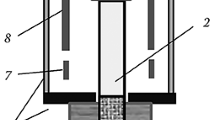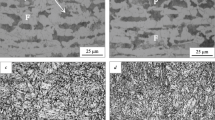Abstract
It is known that cast heat-resistant alloys with a directed structure have a higher high-temperature strength than alloys with an equiaxial structure. For this reason preforms of turbine blades are often produced using the method of directed crystallization, which provides a columnar and single-crystal macrostructure. However, it is difficult to provide a strictly constant orientation of crystallites in batch production of blades. The author analyzes special features of the effect of the orientation of the crystallites on the properties of high-temperature alloys.
Similar content being viewed by others
References
T. P. Gabb, J. Gauda, and R. V. Miner, “Orientation and temperature of some mechanical properties of single-crystal nickel-base superalloy Rene-4,”Low-Cycle Fatigue,6(1) (1986).
V. V. Rtishchev, G. L. Gurskii, and D. M. Bavel'skii, “Effect of process factors on the structural fatigue strength of turbine blades manufactured by the method of directed crystallization,”Trudy TsKTI, Issue 237, 105–116, Leningrad (1987).
B. E. Paton, G. B. Stroganov, S. T. Kishkin, et al.,High-Temperature Strength of Casr Nickel Alloys and Their Protection from Oxidation [in Russian], Naukova Dumka, Kiev (1987).
Yu. D. Yagodkin, V. P. Shulyak, and V. V. Orekhov, “Mechanical properties of nickel alloy crystals with different crystallographic orientations,”Energomashinostroenie, No. 6 30–35 (1987).
L. B. Getsov, “Heat resistance of macroinhomogeneous materials,”Probl. Prochn. No. 5, 23–27 (1981).
R. A. Dul'nev, I. L. Svetlov, N. G. Bychkov, et al., “Orientation dependence of the thermal fatigue of macrocrystals of a nickel alloy,”Probl. Prochn., No. 11, 3–9 (1988).
T. Khan, “Recent developments and potential of single-crystal superalloys for advanced turbine blades,” in:High-Temperature Alloys for Gas Turbines and Other Applications, Part I, 21–50 (1986).
D. L. Mills and M. Leen, “Anisotrolic creep behavior of (Co, Cr)(Co, Cr)7C3 eutectic composites,”Metal Sci., 563–570 (1977).
A. V. Prokopenko, Yu. K. Petrenya, V. N. Ezhov et al., “Mechanisms of fatigue fracture of polycrystalline and single-crystal nickel alloys at temperatures of 293–1273 K,”Probl. Prochn., No. 1, 30–33 (1989).
H. Molner, V. Weiss, and R. Stickler, “The effect of microstructures on the fatigue threshold in copper,” in:Fatigue Threshold. Proc. Int. Conf., Stockholm, 1–3 June 1981, No. 1 (1981).
Author information
Authors and Affiliations
Additional information
Translated from Metallovedenie i Termicheskaya Obrabotka Metallov, No. 3, pp. 13–15, March, 1997.
Rights and permissions
About this article
Cite this article
Getsov, L.B. Effect of crystallographic orientation on mechanical properties of high-temperature alloys. Met Sci Heat Treat 39, 100–102 (1997). https://doi.org/10.1007/BF02466275
Issue Date:
DOI: https://doi.org/10.1007/BF02466275




